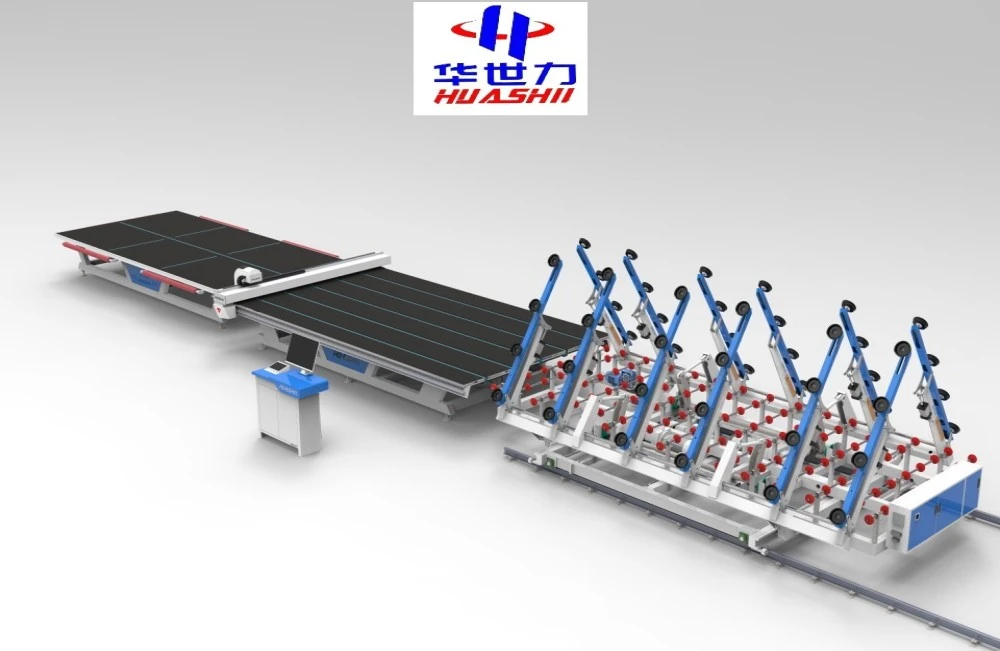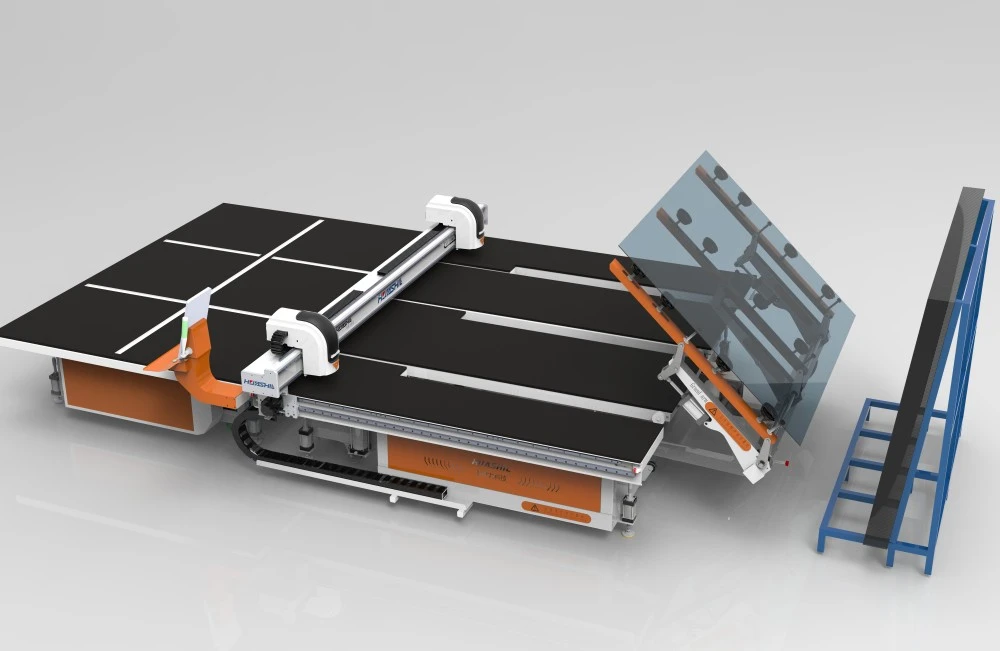Automatic glass cutting machines have revolutionized the glass manufacturing industry, offering precision, efficiency, and consistency in cutting various types of glass. These sophisticated machines have become indispensable in sectors such as architecture, automotive, and smart mirror production. In this comprehensive guide, we'll delve into the intricate workings of automatic glass cutting machines, exploring their step-by-step processes, key components, and the sensors that ensure precise cuts.
Step-by-step process of automated glass cutting
The automated glass cutting process is a marvel of engineering, combining precision mechanics with advanced software to achieve accurate and efficient results. Let's break down the process into its essential steps:
- Glass loading: The process begins with the loading of a glass sheet onto the cutting table. This can be done manually or through an automated loading system, depending on the machine's capabilities.
- Measurement and optimization: Once loaded, the machine's software measures the glass dimensions and optimizes the cutting pattern to minimize waste. This step is crucial for maximizing material efficiency and reducing costs.
- Cutting head positioning: The cutting head, which houses the cutting wheel, moves into position based on the optimized cutting pattern. This movement is controlled by precision motors and guided by a coordinate system.
- Scoring the glass: The cutting wheel, typically made of hardened steel or tungsten carbide, scores a line on the glass surface. This score line creates a controlled stress point in the glass.
- Breaking: After scoring, the glass is broken along the score line. This can be done manually or through an automated breaking system, depending on the machine's capabilities.
- Separation and removal: The cut pieces are then separated and removed from the cutting table, either manually or through an automated system.

Throughout this process, the automatic glass cutting machine maintains precise control over factors such as cutting speed, pressure, and depth to ensure clean, accurate cuts. The machine's software continuously adjusts these parameters based on the type and thickness of the glass being cut.
Key components in a glass cutting machine system
An automatic glass cutting machine is composed of several crucial components that work in harmony to achieve precise and efficient cutting. Understanding these components is essential for anyone looking to operate or maintain these machines effectively:
- Cutting table: This is the flat surface where the glass sheet is placed for cutting. It's often equipped with air flotation to facilitate easy movement of the glass.
- Cutting bridge: This is the movable part of the machine that carries the cutting head across the glass sheet. It's designed for smooth, precise movement in both X and Y directions.
- Cutting head: This component houses the cutting wheel and is responsible for scoring the glass. It can move vertically to adjust for different glass thicknesses.
- Cutting wheel: Made of hardened steel or tungsten carbide, this wheel creates the score line on the glass surface.
- Drive system: This system, often using servo motors, controls the movement of the cutting bridge and cutting head with high precision.
- Control panel: This is the user interface where operators can input cutting parameters, select cutting patterns, and monitor the machine's operation.
- Software: The machine's software is responsible for optimizing cutting patterns, controlling the cutting process, and integrating with CAD systems for complex designs.
- Lubrication system: This system applies a small amount of cutting oil to the glass surface to facilitate smooth scoring and extend the life of the cutting wheel.
- Breaking system: Some advanced machines include an automated breaking system to separate the cut pieces along the score lines.
- Waste collection system: This component collects and removes glass chips and debris produced during the cutting process.
Each of these components plays a vital role in the overall function of the automatic glass cutting machine. The seamless integration of these parts ensures high-quality cuts, minimal waste, and efficient operation.
What sensors ensure precise glass cutting?
Precision is paramount in glass cutting, and various sensors play a crucial role in ensuring accuracy and consistency. These sensors work in tandem with the machine's software to make real-time adjustments and maintain optimal cutting conditions. Here are some of the key sensors used in automatic glass cutting machines:
- Optical sensors: These sensors detect the edges and dimensions of the glass sheet, ensuring accurate positioning before cutting begins. They can also detect any imperfections or irregularities in the glass that might affect the cutting process.
- Pressure sensors: Located in the cutting head, these sensors monitor the pressure applied by the cutting wheel on the glass surface. They help maintain consistent pressure throughout the cutting process, which is crucial for creating clean, even score lines.
- Thickness sensors: These sensors measure the thickness of the glass sheet, allowing the machine to automatically adjust the cutting depth and pressure for optimal results.
- Position sensors: These sensors track the precise position of the cutting bridge and cutting head, ensuring accurate movement and positioning during the cutting process.
- Temperature sensors: Some advanced machines use temperature sensors to monitor the heat generated during cutting. This information can be used to adjust cutting speed or lubrication to prevent overheating and maintain cut quality.
- Vibration sensors: These sensors detect any unusual vibrations in the machine, which could indicate issues with the cutting wheel or other components that might affect cutting precision.
- Glass break sensors: In machines with automated breaking systems, these sensors detect when the glass has successfully broken along the score line, ensuring clean separation of cut pieces.

The data from these sensors is continuously fed into the machine's control system, allowing for real-time adjustments to cutting parameters. This ensures consistent, high-quality cuts even when working with glass sheets of varying thicknesses or compositions.
Moreover, many modern automatic glass cutting machines incorporate machine learning algorithms that analyze sensor data over time to optimize cutting processes further. This can lead to improvements in cut quality, reduced waste, and increased overall efficiency.
Advancements in sensor technology
As technology continues to evolve, we're seeing advancements in sensor technology that are further enhancing the capabilities of automatic glass cutting machines:
- High-resolution imaging sensors: These can detect even the smallest imperfections in the glass, allowing for more precise cutting and reduced waste.
- Laser sensors: These can measure glass thickness with extreme accuracy, enabling more precise cutting depth adjustments.
- IoT-enabled sensors: These allow for remote monitoring and diagnostics, improving maintenance efficiency and reducing downtime.
These advancements are pushing the boundaries of what's possible in automated glass cutting, enabling manufacturers to produce increasingly complex and precise glass components for a wide range of applications.
The role of software in sensor integration
While the sensors themselves are crucial, it's the integration of these sensors with sophisticated software that truly unlocks the potential of automatic glass cutting machines. The software acts as the brain of the operation, interpreting sensor data and making split-second decisions to optimize the cutting process.
Key functions of the software include:
- Real-time adjustments: Based on sensor data, the software can make instant adjustments to cutting speed, pressure, and depth to maintain optimal cutting conditions.
- Pattern optimization: The software can analyze the dimensions of the glass sheet and the required cuts to create an optimal cutting pattern that minimizes waste.
- Quality control: By analyzing sensor data, the software can detect potential quality issues and alert operators or automatically adjust the cutting process.
- Performance tracking: The software can track various performance metrics over time, providing valuable insights for process improvement and maintenance planning.
This sophisticated integration of hardware and software is what sets modern automatic glass cutting machines apart, enabling them to achieve levels of precision and efficiency that were previously unattainable.

Conclusion
Automatic glass cutting machines have transformed the glass manufacturing industry, offering unparalleled precision, efficiency, and consistency. By understanding the step-by-step process, key components, and the role of sensors in these machines, we can appreciate the complex engineering that goes into creating perfectly cut glass for various applications.
As technology continues to advance, we can expect to see even more sophisticated automatic glass cutting machines with enhanced capabilities. These advancements will likely include more advanced sensors, improved software algorithms, and greater integration with other manufacturing processes.
For businesses in the glass manufacturing industry, investing in high-quality automatic glass cutting machines is crucial for staying competitive in today's market. These machines not only improve production efficiency and reduce waste but also enable the creation of more complex and precise glass components that meet the evolving demands of industries such as architecture, automotive, and electronics.
At Shandong Huashil Automation Technology Co., LTD, we understand the critical role that automatic glass cutting machines play in modern manufacturing. Our team of experts is dedicated to providing cutting-edge solutions that meet the unique needs of our clients. With years of experience in R&D, manufacturing, and sales of automated mechanical equipment, we offer advanced techniques, stable quality, and excellent service that have made us a trusted partner for customers worldwide.
If you're looking to enhance your glass cutting capabilities or explore how automatic glass cutting machines can benefit your business, we invite you to reach out to us. Our team would be delighted to discuss your specific needs and provide tailored solutions. Contact us at salescathy@sdhuashil.com to learn more about our products and services. Let's work together to elevate your glass manufacturing processes to new heights of precision and efficiency.
References
1. Johnson, M. (2022). "Advancements in Automatic Glass Cutting Technology: A Comprehensive Review". Journal of Glass Manufacturing, 45(3), 112-128.
2. Smith, A., & Brown, B. (2021). "Sensor Integration in Modern Glass Cutting Machines". International Conference on Industrial Automation, pp. 234-249.
3. Lee, C. (2023). "Optimization Algorithms for Efficient Glass Cutting: Current Trends and Future Prospects". Glass Processing Quarterly, 18(2), 67-82.
4. Zhang, X., & Liu, Y. (2022). "The Impact of IoT on Glass Cutting Machine Maintenance and Performance". Smart Manufacturing Systems, 7(4), 301-315.



